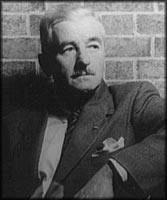|

|
Faulkner’s As I Lay Dying: Burying Addie's Voice
Guiding Questions
- How does Faulkner's form for the novel—a series of competing voices and perspectives presented as a multiple-voice narrative—work for or against the novel's title?
- What impact does the sudden voice of a silenced (and dead) character have on the narrative? How does Addie's voice change the reader's perception of the Bundren family?
Learning Objectives
After completing the lessons in this unit, students will be able to:
- Understand and explore the use of multiple voices in narration
- Describe in detail Addie Bundren's character both from her own as well as other characters' perspectives
- Examine the Bundren family through the subjective evidence provided by multiple characters
Preparing to Teach this Lesson
Review the curriculum unit overview and the lesson plan. Locate and bookmark suggested materials and other useful websites. If necessary, download and print out any documents you will use and duplicate copies as necessary for student viewing.
Activity
This activity explores Addie, the central character of the text. The novel's title—As I Lay Dying—invokes a first-person speaker, presumably the voice of the dead mother, Addie Bundren. Yet she only speaks once in the novel, and she is dead, not dying, throughout most of the novel (aside from the beginning chapters). The remainder of the text details the thoughts and activities of all the people surrounding her. Addie herself speaks only once, after her death.
Before specifically discussing Addie's chapter, have students consider:
Who is Addie Bundren to each of the characters who speak of her?
What are the relationships like between Addie and her children? Addie and her husband?
Read aloud the 10th Darl section, which contains a revealing passage:
It [the New Hope sign] wheels up like a motionless hand lifted above the profound desolation of the ocean; beyond it the red road lies like a spoke of which Addie Bundren is the rim. It wheels past, empty, unscarred, the white signboard turns away its fading and tranquil assertion. (p. 108, Vintage edition, 1990)
Have students discuss this image—the road "like a spoke of which Addie Bundren is the rim"—in depth. Draw the shape of a wheel on the blackboard, labeling the rim as Addie. Ask students to consider how this reflects the structure of the story. Students might discuss:
- The symbol of the wheel—how can this be interpreted in relation to family? To narrative form? If Addie is the rim, what or who might the spokes represent?
- Why is the "New Hope" sign a "fading and tranquil assertion"? Is there a role for "new hope" in this novel? [Students will return to this question in Lesson 5: Concluding the Novel.]
Addie's voice comes to the reader only after her rotting body was pulled from its "baptism" in the river after the disastrous crossing. Questions that might be valuable in discussing her chapter:
- Where is her voice coming from, since she is at this point quite dead?
- What is the placement in the novel of Addie's chapter, and what is the significance of that placement? Consider who frames Addie's chapter: Cora before and Whitfield after.
- How do our impressions of Addie change once we encounter her voice?
- How does Addie's perspective cloud or illuminate the themes and issues that we have encountered so far through the other characters' perspective?
- What do we learn about her role in the family, and how does that compare to how her children and husband view her? She comes across as bitter, but are the motives of her family any more pure?
Addie displays bitterness about the very fact of existence and a preoccupation about death: “I could just remember how my father used to say that the reason for living was to get ready to stay dead a long time.” She expresses distaste for her students and difficulty relating to her children. She implies that she married Anse for his property and that “living is terrible” after she has Cash, who “violated” her aloneness. Darl’s birth makes her want to kill Anse; she refers to him as “dead,” though he doesn’t know it. She is skeptical about love, which she refers to as a “word . . . like all the others: just a shape to fill a lack.” In fact, she questions the authority of language and the possibility for meaning: “That was when I learned that words are no good; that words don’t ever fit even what they are trying to say at.”
Further questions to consider:
- What might be the reasons that Faulkner reveals Addie’s interior life only once?
- Do the characters’ assessments of Addie match with the portrait she paints of herself? Students can refer to their charts (started in Lesson 2) in order to detail Addie’s relationships with her family and community.
- Why does Addie express uncertainty for meaning in language? How might that theme relate to the presence of her own voice in the narrative? What of the voice of the author?
Some students might have difficulty understanding the historical situation of women in the 1920s. Teachers might remind students, for example, that women had just won the right to vote with the 19th Amendment. You may draw additional historical context from the History Channel Timeline (the link starts at 1920—the menu at the top will take viewers through the rest of the decade), available through EDSITEment reviewed Internet Public Library. Teachers might also emphasize the difference between the agricultural-based south and the industrial north.
Extending the Lesson
Compare As I Lay Dying to other stories about adulterous relationships that the student might have read during class, such as Hawthorne’s The Scarlet Letter or Kate Chopin’s “The Storm.” How does Addie’s relationship with Whitfield compare to Hester Prynne’s with Dimmesdale or Calixta’s with Alcee?
Selected EDSITEment Websites
Internet Public Library
Standards Alignment
View your state’s standards
|





